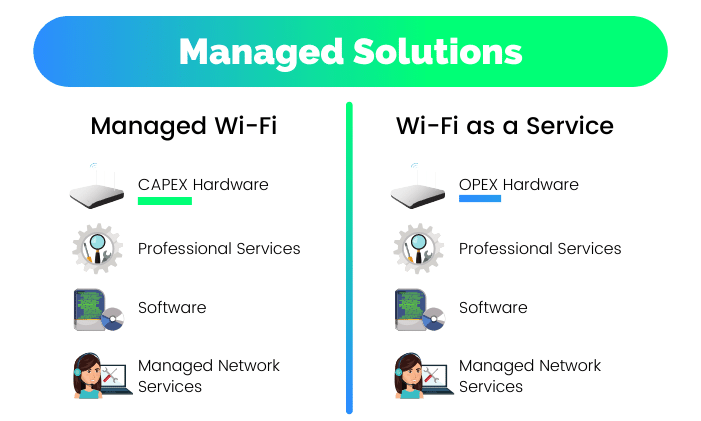
With all the dynamics of professional environments and the complexity of wireless connectivity, a lot of businesses are beginning to move towards innovative solutions to deliver mission-critical WiFi to its daily operations.
Whether you have multiple locations, a small IT team, or in the case that you want to outsource your WiFi, implementing a managed wireless network provides solutions to the frustrations and cost for the everyday entrepreneur, the business-running CEO, and even the support-needing CIO.
Traditional WiFi Trending Towards Managed WiFi
Today, businesses typically purchase their networking infrastructure from value-added resellers (VARs), who act as a “middle-man” between the distributors and the end-users. Typically, VARs sell hardware such as access points, switches, firewalls, controllers, and performance sensors—some even go well beyond networking equipment.
There’s one big problem with this system. Most VARs don’t provide proper (if any at all) professional services with the equipment that they’re supplying to their customers.
In traditional buying, there is no engineering provided on the front-end, which means:
- NO WiFi assessments
- NO RF design (RF plans, WiFi heat maps, predictive designs)
- NO installation or configuration
- NO validation site surveys
There’s also rarely any post-sales management and remediation offered, which is scary considering that many businesses don’t have the internal capabilities (time, skill-set, experience, etc.) in order to properly maintain their networks over time.
At SecurEdge, we’ve always said that “the application will drive the infrastructure,” meaning that what you’re doing (or trying to do) will determine how your network should be designed and what you actually need to be successful – which can only be done by industry-leading engineers.
Since WiFi requires engineering and ongoing management to achieve optimal results (which most resellers don’t have the ability to deliver), businesses are no longer settling for just a product.
They want the entire network packaged for them to ensure that their network is engineered correctly on the front-end and then managed for them (post-sales/implementation) on the back-end to guarantee performance. Which is why a lot of businesses are turning to managed WiFi solutions.
If you’re interested in learning more about the importance of proper engineering and design, check out this blog: Understanding the WiFi Engineering Process Step-By-Step Guide
Managed WiFi & What You Should Look For
Since WiFi has become as necessary as water and power, the tech world had this great idea - let’s turn it into an “operational expense” (OPEX)! In the same way that people get billed for water and energy each month, customers would also get billed for networking services every month. Not only would your network be handled for you, but it would also be bundled together in a single subscription.
Sounds great, right? Well, it is - except for the fact that many companies who are offering a managed solution are leaving out critical services that do more harm than good for the end-user.
We often see “Managed WiFi” being offered incorrectly, as seen in the example below:
Company A sells you the hardware you need as a CAPEX and then Company B sells you services on top—usually an MSP (managed service provider).
The issue is that Company A doesn’t include professional services with their hardware—which is a big problem—and then Company B, who is managing the network, typically is operating outside of their core competency and only providing basic monitoring. They also tend to be local partners and don’t have a national reach.
So, what is Managed WiFi? – "Managed WiFi" is when a company purchases all of the necessary WiFi and networking hardware as a capital expense (CAPEX) then bundles professional services with advanced software and managed network services on one subscription (OPEX).

There’s only one company, that we know of, that provides true Managed Wi-Fi—us.
Another Option: WiFi as a Service
When it comes to delivering wireless, WiFi as a service is another flavor that customers can choose from that offers a completely OPEX solution.
“WiFi as a Service” is when a company purchases all of the necessary WiFi and networking hardware, professional services, advanced software, and managed network services all on one subscription (OPEX Only).
The only difference between Managed WiFi and WiFi as a Service is how it’s bundled: with Managed WiFi, the hardware is purchased as a CAPEX and with WiFi as a Service, the hardware is purchased as an OPEX.
Both options are considered managed solutions, but the real deciding factor is found in how the hardware is purchased; You are either providing all the money for equipment upfront or paying for it on subscription.
The aspect of ownership is also something to take into consideration, however, it is important to keep in mind that technology is constantly changing so the network you have now will need to be replaced. According to our engineers, due to the rapid growth of technology, wireless networks need to be replaced about every four to five years.
Both Managed WiFi and WiFi as a service offer the most affordable, comprehensive way to deliver WiFi today, while also being customizable and therefore make a great option that businesses should consider.
Learn more about WiFi as a Service
A Requirements Checklist from the Experts
From our years of experience, and for the sake of keeping things simple, we have laid out a requirements checklist to keep in mind when shopping for a managed solution.
Requirements Checklist for a Managed WiFi Solution:
- Do they offer pre-assessment services (i.e. WiFi site surveys, WiFi analysis)?
- Do they offer custom WiFi Designs engineered from industry-certified experts?
- Do they offer industry-leading WiFi hardware?
- Do they include all the installation and configuration of your network?
- Do they perform a validation site survey?
- Do they offer full system support services for firewalls, switches, access points, and sensors?
- Do they have integrated IoT security?
- Do they include network access control (NAC)?
- Do they schedule network refreshes?
- Do they offer performance monitoring?
- Do they include SLAs on response times?
- Do they provide weekly and monthly network health reports?
- Do they offer tier 2 and tier 3 support?
Making an Informed Decision with a Beneficial Partnership
Once you’ve decided to get a managed solution, either Managed WiFi or WiFi as a Service, instead of the traditional DIY networks, it’s essential that you select the right fit for you.
Take time to look at your business objectives, the applications you’ll be using to drive those objectives, and your new Requirements Checklist for a Managed Solution.
Never underestimate the power in choosing a technology partnership with the people who can best help your business in accomplishing its goals.






